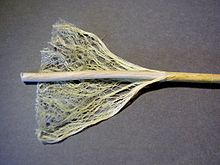Bast fiber
Plant fibers are referred to as bast fibers , which are in the form of multicellular fiber bundles in the bast of various plant species . They are elongated and thick-walled cells , as a result of which they have only a very narrow cell space ( lumen ), which are not lignified and usually taper to a point at both ends.
Layout and function
One of the main functions of these fibers within the plant is to stiffen the structure in order to give the stem sufficient stability. The main component of bast fibers are essentially layers of cellulose fibrils of different thicknesses . These are fine, elongated structures that are arranged concentrically and surrounded by hemicellulose . The arrangement of the fibrils has a great influence on the mechanical properties of the fiber and varies depending on the type of fiber. While the cell wall of the bast fibers in the young state consists exclusively of cellulose fibrils, cement substances are formed over time that connect the fibrils with one another. These putty substances are pectin and lignin , although the proportion of these substances can vary greatly depending on the type of plant. So that has kenaf a lignin content 15-19%, but has virtually no Pektinbestandteile, while in a ramie average of only 0.6-0.7% lignin, but for about 2% of pectin can be found.
The bast fibers are of different lengths and diameters depending on the type of plant. The elementary fibrils of flax are on average 33 mm long and approx. 19 μm in diameter, whereas the elementary fibrils of hemp are on average 25 mm long and 25 μm thick, while those of the ramie plant are 40 to 350 mm long and 40 to 50 μm in diameter Diameter. However, it should be noted that the nature of the fibers and their composition always depend on the growing conditions of the plant and can vary greatly. Mechanical or chemical processes are used to detach the bast fibers from the plant stem ( fiber breakdown ).
use
Due to their mechanical properties, the bast fibers of many fiber plants are processed into ropes, yarns, mats or fabrics that are used in both textile and industrial areas. In addition to their application in the clothing sector, these natural fibers have been increasingly used in recent years as reinforcement fibers for natural fiber composites. In addition, in China since approx. 2000 and in Japan for approx. 1400 years ago made from the bast fibers of the paper mulberry tree ( Kozo ). Paper ( Kozogami ).
The best-known commercially used bast fiber plants are useful hemp ( hemp fiber ), flax fiber ( flax fiber ), nettle fibers , ramie , kenaf and jute . In Central Europe, before flax and hemp were used as fiber plants, the bast of linden and oak was preferred .
literature
- Klaus-Ulrich Heyland, Herbert Hanus, Ernst Robert Keller (eds.): Oil fruits, fiber plants, medicinal plants and special crops. Eugen Ulmer, Stuttgart 2006, ISBN 3-8001-3203-6 .
- Robert R. Frank: Bast and other plant fibers. Woodhead Publishing Limited, Cambridge 2005, ISBN 1-85573-684-5 .
- Kim L. Pickering (Ed.): Properties and performance of natural-fiber composites. Woodhead Publishing Limited, Cambridge 2008, ISBN 978-1-84569-267-4 .
- Amar K. Mohanty, Manjusri Misra, Lawrence T. Drzal, (Eds.): Natural fibers, biopolymers, and biocomposites. Taylor & Francis Group, Boca Ranton, FL 2005, ISBN 0-8493-1741-X .
- Friedrich Tobler : Raw material bast fiber. In: Materiae Vegetabiles . Issue 1, Number 2, February 1953, ISSN 0921-9668 , pp. 183-188.
- Marianne Leupin: Bast fibers: substitutes or textile raw material basis of the future? In: International Textile Bulletin. Issue 46, 2000, pp. 22, 24, 26.
Individual evidence
- ↑ Johannes Hoops, Heinrich Beck, Dieter Geuenich, Heiko Steuer: Reallexikon der Germanischen Altertumskunde. Volume 33, deGruyter, Berlin 2006, ISBN 3-11-018388-9 , p. 114.

